Poignant moments in Osaka and Hiroshima
Sumo in Osaka, Hiroshima's Miyajima island, the Peace Memorial Museum, and now to bike shimanami kaido
Watching Osumo-san, お相撲さん
I did not know what to expect when we purchased our sumo tickets back in Feb. My dad had great memories of a sumo tournament that he went to like forty years ago. His enthusiasm over that phone call, all this time later, was very convincing. We immediately looked up when the next tournament was (end of March in Osaka) and bought a ticket for a random day (each tournament is sixteen full day sessions). We planned our entire March itinerary around this single day, and wow, I do not have regrets! We had the best time.
It is not a high action sport. The rules are simple. Two osumo-san face each other off on a raised clay platform with a large circle drawn on the ground. Each wrestler tries to push the other out of the circle or to the ground.
The bout itself, the pushing and wrestling, lasts up to a minute at longest. The length of the match though can go 4-5 minutes. The osumo-san do a lot of ritual preparation and showmanship on the platform and do not need to start the bout until the four-minute mark. They bow to one another. They clap their hands to wake the gods, stomp their feet, spread their arms to demonstrate sportsmanship. They meet in the middle, squat low, and get into starting position only to stand up again. They go to their respective corners, scoop salt from a bucket and throw it into the ring (an auspicious act), towel off their face and shoulders, face one another again… and repeat.
The slowness of it was fascinating. The match was as much about the ritual preparation and performance as the wrestling. The sport is part of old shinto tradition. When they went to repeat the rituals for a third time, pushing towards the four-minute time limit, the crowd loved it. Great applause filled the stadium as the wait was further prolonged and the sense of anticipation for the bout was raised.
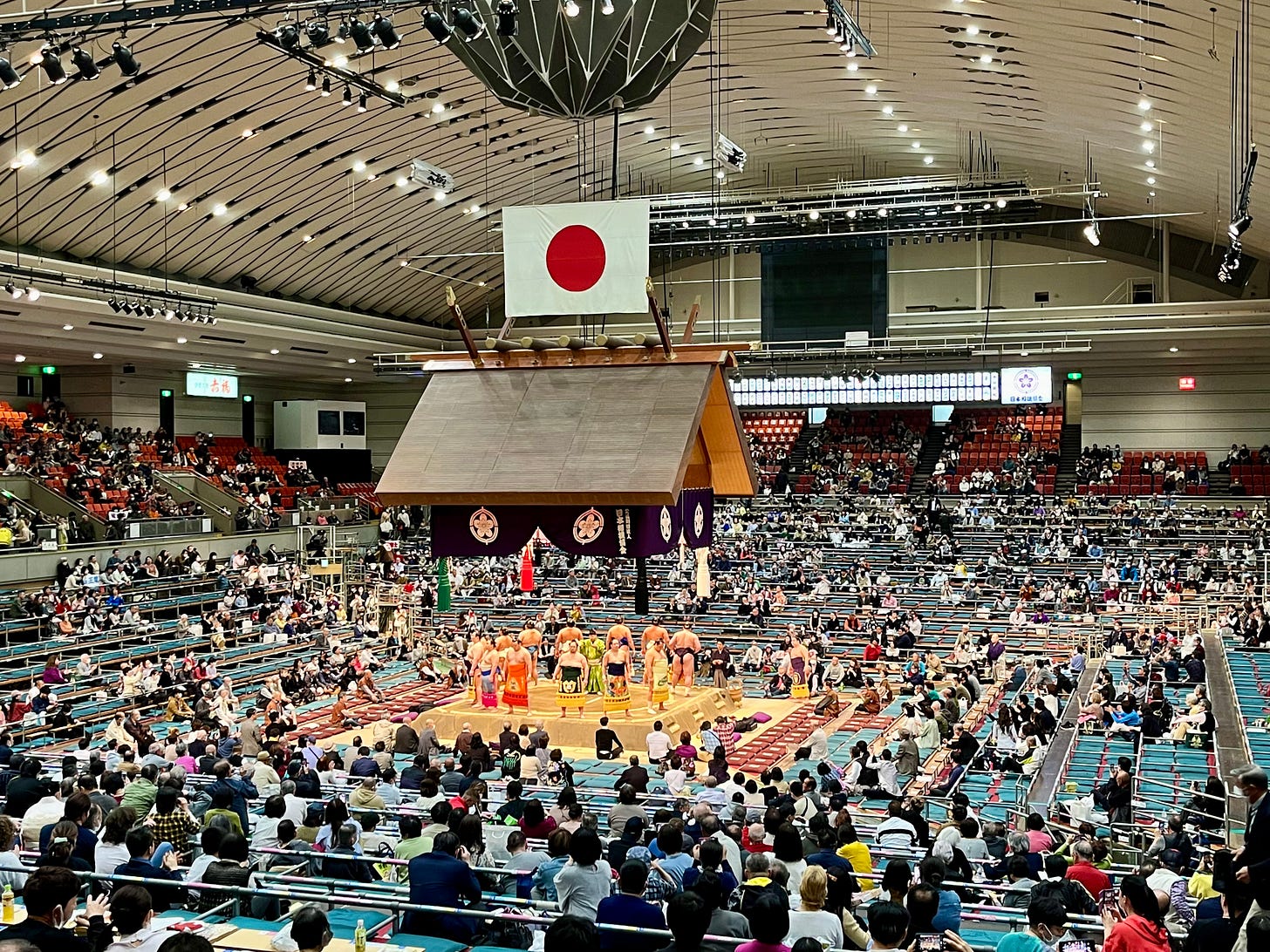
Osumo-san are quite large people, height-wise as well as weight-wise. A surprising number were around 6+ feet tall when I googled a few. I think the small ones are also large, but they look small comparatively. Not all were Japanese. Some were from Mongolia. There was one from Georgia the country and “Big Dan” from Bulgaria. These two had big followings. There were the “old school wrestlers” (my term), who were a big deal over the last 5-10 years, perhaps fading in their glory nowadays. And there were the up-and-comers and current champions. The audience clearly loved all these different groups of wrestlers, and welcomed each with warm and eager applause as they were announced. We saw over 70 matches from 12:30 to 5:30pm.
One of the most poignant moments for me, I partly captured in the two photos below. This was a youthful-looking, older woman who arrived maybe 30 minutes after Raghav and I did, all of us a little early for the afternoon session. She sat quietly and attentively with straight posture for over four hours. I wondered what her purpose at this sumo tournament could possibly be. Then literally in one of the final matches of the 70+ that we saw, she unassumingly pulls out a towel, carefully unfolds it, and thrusts her arms forward with emphasis. She proceeds to hold it there for the whole match. The towel is printed with the name of her favorite osumo-san, Shōdai, who is more of a veteran wrestler at this point. At last she calls out in her small voice, as loud as she dares (not very loud), and with Japanese sincerity and conviction, “Shōdaiii!”


I am honestly a little heartbroken to say that Shōdai did not win his match. There was about three minutes of pre-bout preparation. He and his opponent finally put their fists to the ground to start the wrestling and Shōdai lost rather decidedly in thirty seconds.
I felt a little sad as I watched her take the loss in stride. She carefully folded the towel, placed it back in her bag, and folded her hands in her lap. Shōdai’s biggest fan had attentively waited hours to support him for three and a half minutes. She had mustered the courage to put herself out there a little, as she held the towel and called out her only cheer that afternoon. I left the stadium sending up a prayer for Shōdai’s future performances, if for no other reason than on behalf of his biggest fan.
Beautiful Hiroshima by the water
Maybe I should use an “I” statement here, but I think it may be safe to say that our understanding of Hiroshima in the US is in relation to the dropping of the first atom bomb by the US military. This is in contrast to how many of my Japanese friends think of Hiroshima. They often comment on how it is a beautiful place to visit and a desirable place to live, a place that people move to. So it was a pleasure to see Hiroshima for myself. It left an impression on me that is similar to what I heard in my friends’ voices when they spoke of it.
Hiroshima is a charming city, smaller than many of the others we have visited. There are many cute, small cafes, restaurants, bakeries, stores, and small businesses. The buildings aren’t built up as a high. It’s more to-scale to people. The city is divided by canals and rivers that link directly to the sea. Bridges connect the isles and create a unified cityscape. Mountains break the horizon, smaller hills loom tall within the city itself. The sea is gorgeous, along the south side of the city. Along the sea, you can see green, thick forests on the islands off the coast, all reachable by a short ferry ride.
We took a popular tourist day trip to the island Miyajima known for a seaside shrine with torii in the sea. Miyajima hosts that typical Japanese tourism experience: go by train, bus, and/or ferry, walk around and see the locale, visit the local shrine (oftentimes it is famous), eat the iconic food (oysters and momiji manjū, in this case), and take in the natural view, usually from a small mountain accessible by a moderate hike or cablecar. We hiked up and I took the cablecar down without Raghav who hiked back down. It was a charming, picturesque, idyllic day.
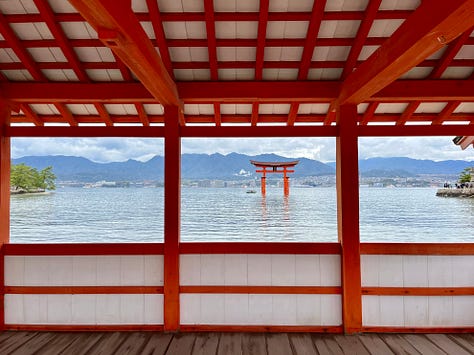
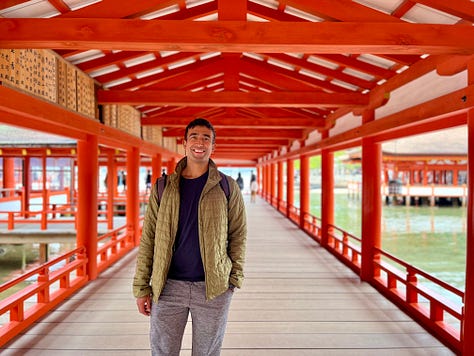
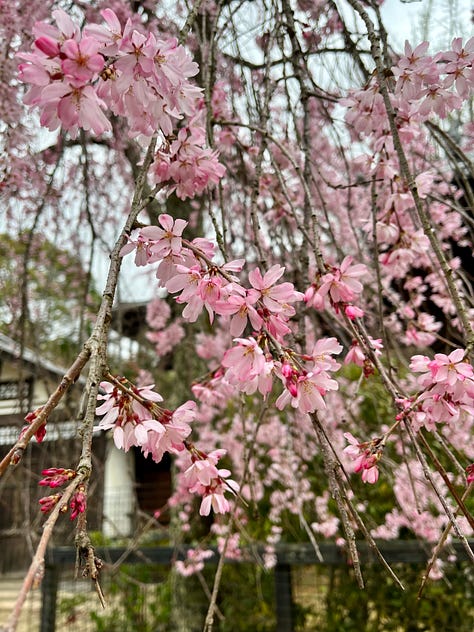
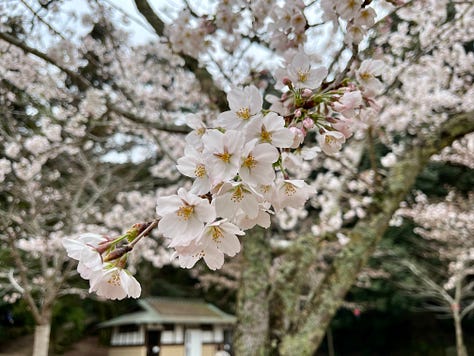
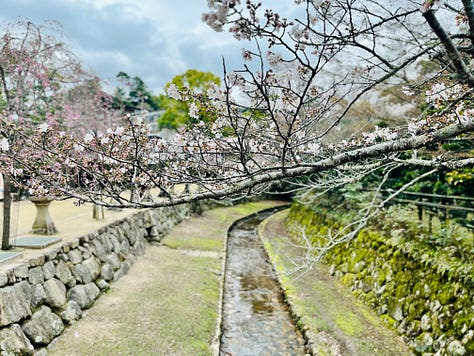
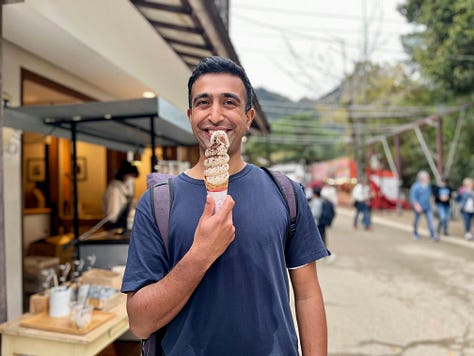
The tourist season has begun over the last two weeks. Raghav and I have had a harder time reserving seats on Shinkansen. There are much bigger crowds everywhere we go. We hear a lot more foreign languages. There were groups of German, French, Italian, Spanish, and American tourists on Miyajima, also a few big Indian families, one Gujarati and another South Indian family. There were also many Japanese tourists. Occasionally we’d spot a large group of older Japanese dutifully following their tour guide with the orange flag.
A brief statement about the Peace Memorial Museum
The Hiroshima Peace Memorial Museum records the events of the day that the atom bomb was dropped on August 6, 1945, and the very long aftermath of its impacts. A lot came up for me in viewing this memorial and museum, much of which I continue to reflect on.
The photographs, artistic renditions, and narrated accounts of the people who survived the A-bomb were gruesome, shocking, and horrific. There are no words that can effectively convey what this day and its ongoing aftermath inflicted on people. I won’t go into the details here of the horrors of that day, but it is in the details of what specifically happened to people’s bodies that is important to know as part of the understanding that this should’ve never happened. That is the thought that I emerged with from this exhibit and memorial, that the atomic bombs used on Hiroshima and Nagasaki should have never been used, and that it was a crime against humanity.
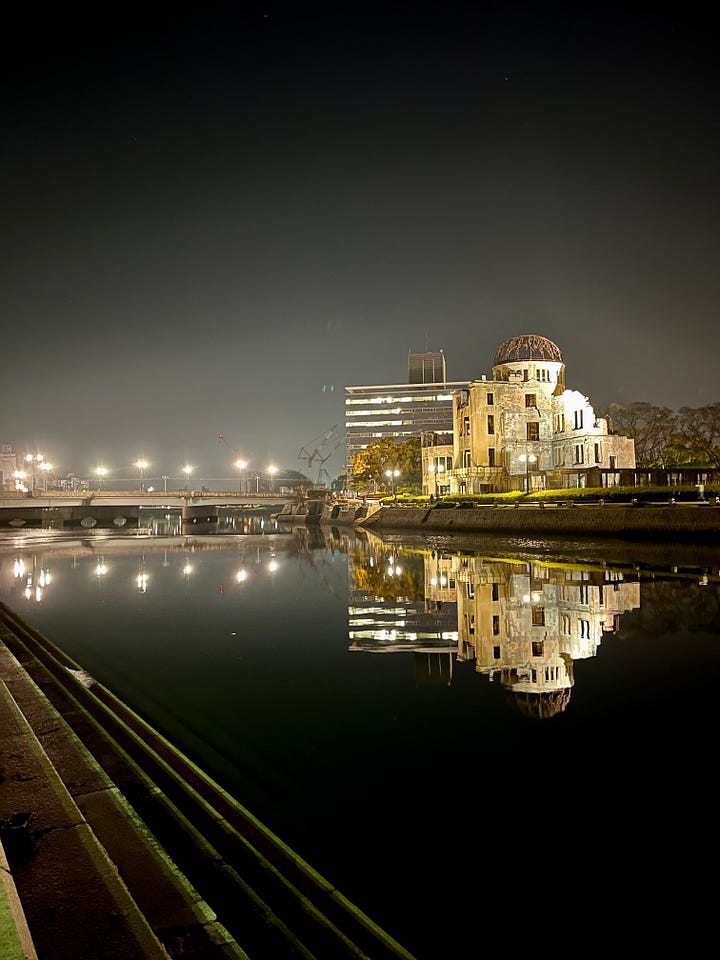

After leaving the exhibit, I saw many people sitting on benches in the outer hall in a daze, dissociated, some crying. I joined them for a while as I waited for Raghav. It was hard to walk out of the museum and reconcile the present-day Hiroshima with that day, August 6th, nearly eighty years ago. Truthfully I just don’t understand how these two places are the same place. It felt important to visit this museum as an American, to be face-to-face with this cultural inheritance. I think America needs a museum and memorial like this that shares what exactly happened to the people of Hiroshima and Nagasaki when the atomic bombs were dropped.
Now to transition into the last part of this post.
Shimanami kaido
Raghav and I are currently in Onomichi, a port city located to the north of a chain of nine islands that are connected by a single highway, the shimanami kaido. Tomorrow we begin our two-day bike journey along the shimanami kaido. It is a popular activity and well trodden. We bike to the midpoint of our journey and stay at an onsen ryokan. In total, we will bike about 70 km, finishing in Imabari on Shikoku, the smallest and most remote of Japan’s major islands. Raghav has super looked forward to this since he learned about it, probably a year ago now. For me, it is a last, big energetic push and a final outing into Japan’s more provincial natural beauty. On Wednesday, we will head to Tokyo where we stay for our final week in Japan.


